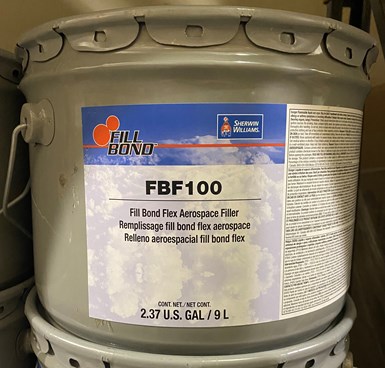High-Flexibility Aerospace Filler Fills Seams, Rivets, Small Spot Repair Areas
Fill Bond Flex Aerospace Filler restores aircraft exteriors by concealing surface imperfections.

Photo Credit: Sherwin-Williams
Fill Bond Flex Aerospace Filler (FBF100) from Sherwin-Williams Aerospace Coatings is a convenient method for filling seams, rivets and small spot repair areas on aircraft prior to painting. The high-quality, two-component polyester filler kit is designed to block and permanently conceal surface imperfections on composite exterior aircraft surfaces. The lightweight filler provides performance, versatility and productivity by offering strong adhesion, resistance of shrinkage, sandability, flexibility and stain resistance, making it well suited for creating smooth surfaces for topcoat applications.
FBF100 comes in a mechanical dispenser package with an included hardener. The solution does not require priming and cures quickly, increasing shop productivity and reducing the process time for topcoat preparation. High-flexibility body filler is good for filling the weave structure of composite materials, as well as any dents, scrapes and scratches. The product is available in light gray and is compatible with Sherwin-Williams aerospace topcoats.
“When coating an aircraft, you want to hide every surface imperfection possible for a very smooth and aesthetically pleasing final finish,” says Julie Voisin, market segment manager, aerospace, OEM interior and commercial vehicle refinish. “We’re making that process easier for composite aircraft with Fill Bond Flex Aerospace Filler, giving users a sag-resistant, cartridge-based application option that enhances their finishing speeds and delivers optimum results.”
For the best outcomes, applicators should abrade the surface or filler with an 80-grit sandpaper or via another comparable procedure. Then, they should apply the filler to a clean, dry surface that is free of dirt, dust, oil, grease and wax, using a plastic spreader. Thin layers should be applied to any damaged areas using firm pressure to promote maximum adhesion. Additional layers should be added to build up damaged areas higher than the metal surface to enable sanding. However, excessively thick layers in one application should be avoided. Surfaces should always be air-blown and tack-wiped to be painted.
Related Content
-
Hexavalent-Chromium-Free Aluminum Sacrificial Paint Validation
Hexavalent chromium is a known carcinogen, repro-toxin and mutagen. Its elimination is of high importance to the aerospace industry, which has struggled to find high performing alternatives. Legacy aluminum sacrificial paints have traditionally utilized hexavalent chromium to prevent corrosion and coatings which are equal to or better than have been difficult. This second of two papers discusses the hexavalent-chromium-free process from the user point-of-view in terms of the process validation work by Rolls Royce Corporation.
-
A Smooth Transition from One Anodizing Process to Another
Knowing when to switch from chromic acid anodizing to thin film sulfuric acid anodizing is important. Learn about why the change should be considered and the challenges in doing so.
-
Finishing High Reliability, Function Critical Parts
From safety critical automotive and aerospace components to lifesaving medical micro-components and implantable devices, Indiana-based Electro-Spec finishes applications that require zero failure rates.












